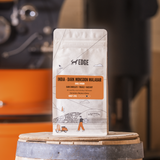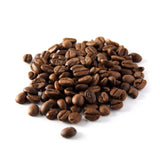India - Dark Monsoon Malabar
India • Single OriginRoast level
An earthy and smoky full roast, Indian coffee with a smooth nutty finish.
How To Recycle Me

Our tea & coffee packaging is 100% recyclable.
Our coffee bag supplier is carbon neutral & the bags are grade 4, which is 100% recyclable!
Find a collection point in your local supermarket or enquire if your local council will accept this type of bag at kerbside.
Check your local collection point here.
- Region - Southern India – Karnataka, Western Ghats
- Growing altitude - 1100-1200m above sea level
- Varietals - Kents, S.795, Catimor, Selection 9
- Harvest Period - October-February
- Process - Monsooned
- Taste notes - Earthy, spicy and smoky tobacco and wood with notes of dark chocolate, treacle and hazlenut.
The colour, shape, and size of these beans from India, as well as their aroma and taste, are the result of special post-harvest processing. Historically, coffee was shipped to Europe in wooden sailing vessels that took four to six months to sail around the Cape of Good Hope and up at their destinations. Stored below the water line and kept in an atmosphere made humid by seawater seeping through the wood, the beans underwent a transformation on their long journey to market. The bright-green beans would arrive pale gold, doubled in size and with an entirely new cup profile.
This “monsooning” process was later systematically replicated in India, with the goal of providing European customers with the cup profile they’d first become accustomed to from India and continued to demand.
The monsooning process consists of exposing natural coffee beans, in 4 to 6 inch thick piles, to moisture-laden monsoon winds in a well-ventilated brick or concrete-floored warehouse. This process is carried out on the West Coast of India, making use of the winds from the Arabian Sea during the southwest Monsoon months of June through September.
The processing begins with top-grade beans, Arabica cherry AB, that has already been processed by the dry method. To equalize moisture absorption, the beans are raked frequently, followed by bulking and re-bagging at regular intervals. During this 12 to 16 week process, the beans absorb moisture in stages, swelling to nearly twice their original size and developing colours ranging from pale gold to light brown.
After several weeks, the coffee is re-bulked, graded again, bagged and moved to a drier region for longer-term storage. The end result is a unique flavour that (like liquorice or cilantro) appeals to a group of ardent fans. It adds interesting notes to a blend and a rich crema to espresso
Love Asian Coffee? Get 15% Off Every Order When You Subscribe!
How It Works:
- Select your favourite coffee origin.
- Choose your grind, weight, and delivery frequency.
- Enjoy 15% off every order—never run out of beans again!
Orders over £35 qualify for FREE DELIVERY.
Each bag is hand-roasted and sourced from the latest African harvest, giving you the freshest flavours while supporting amazing coffee producers.
Why Does My Coffee Change?
Our single origin coffees are sourced as high-quality, unique micro-lots. This means there is only a limited amount available, and we’re lucky enough to have some. While we will always have fresh coffee from your favourite origin, individual coffees change as stocks run out. We replace them with equally delicious coffees, allowing subscribers to experience a variety of exceptional beans throughout the year.
Our sourcing highlights the diversity of regions, producers, varietals, and processes—ensuring you get the best of Brazilian coffee.
Will My Subscription Price Change?
No! Once you subscribe, your price will stay the same when the coffee rotates.*
The Benefits Of A Kilo Bag
Choose a 1KG to make up to 50 cups of coffee and use less packaging - better for your pocket and the planet!

Better
Value

Less
Packaging

Fewer
Deliveries
Why not try...


Burundi - Migoti Mountain Peaberry
Flavour Notes
Roast level
Flavour Notes


Brazil - Fazenda Pinhal
Flavour Notes
Roast level
Flavour Notes


Dark Side of the EDGE | Great Taste Award Winner
Flavour Notes














